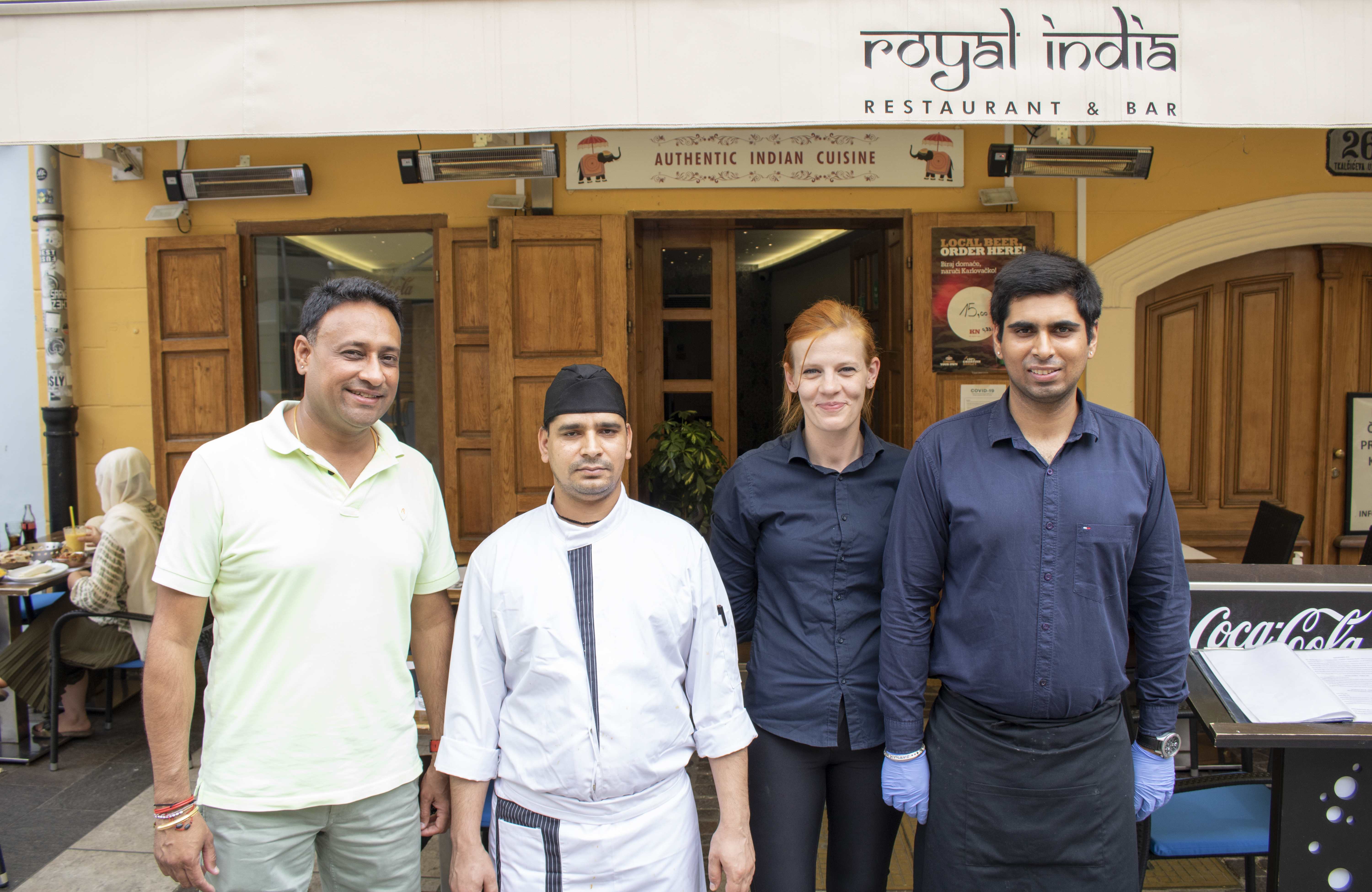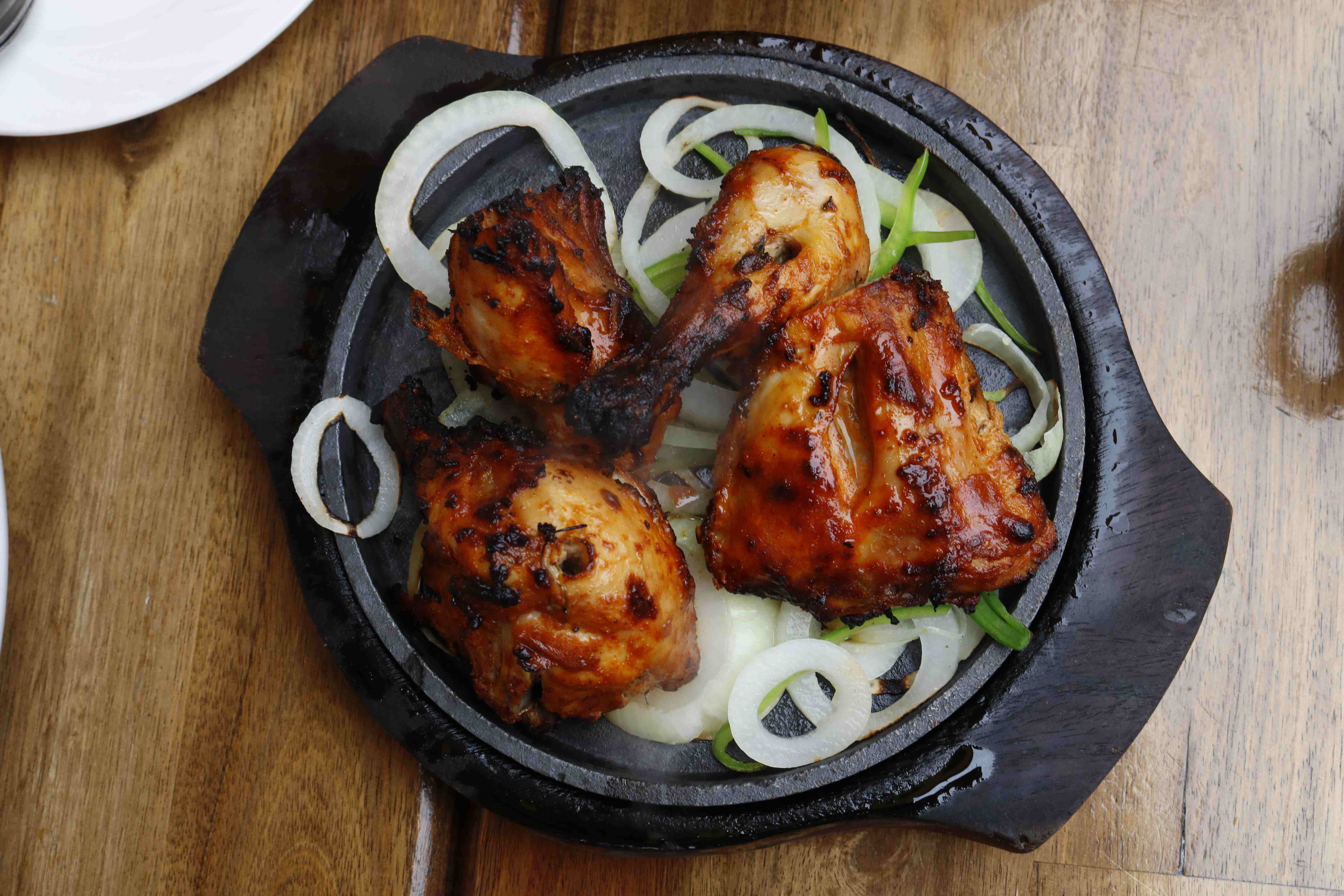August 3, 2020- Continuing our series on Zagreb’s international food offer and the stories behind these cuisines and businesses. This time, from Punjab to Tkalčićeva; Royal India.
Royal India in the heart of Zagreb is the longest standing restaurant that sells Indian food. Like its chefs, owner Satinder comes from north India, the area’s distinct cuisine of spicy curries, oven-baked and marinated meats, and inviting breads synonymous with the Indian restaurant offer around the world.
Satinder Pal Singh (far left) and some of the staff of Royal India © Vedran Pažin
My name is Satinder Pal Singh. I’m from the northern part of India, a city called Chandigarh. It’s the capital of Punjab and Haryana. It’s near New Delhi. I say near, it’s 250 kilometres away.
Here at Royal India we serve authentic Indian food. Mainly we concentrate on food from north India. The food from the north is totally different from food in the rest of India. In the south, the kitchen is totally different; dosas, fish. If you eat Indian food anywhere else in the world, 99% of the time you will be eating recipes from the north of India. It’s the most popular cuisine of India. We have a lot of different kinds of curries – chicken, lamb, and many vegetarian dishes - chicken tikka butter masala is the most popular one we make at Royal India. Northern India cuisine also comes with more bread than that in the south - naan breads made plain, with meat, with onion, with garlic, and chapatis. We always use Basmati rice. Only. That is very typical of Northern India. They use long grain rice in the south. Basmati rice has the best aroma, flavour, and texture (this is true – Kitchen Editor). We use Basmati rice because it grows in the north.
We use very different spices and flavours in Northern India cuisine. In the south, they use curry leaves, coconut, things like this. We use cardamom, cumin, fresh coriander and coriander seeds, star anise, black pepper, bay leaves, cinnamon, and a lot of spice mixes. We grind spices and mix them together in known amounts. The resulting mixture is called garam masala. We make our own specific garam masala here on the premises. We buy only whole spices. They are always the best. Whole spices stay fresh for longer and give a better aroma. The garam masala can vary from region to region. Across northern India, it is almost exactly the same. Within the restaurant setting, it depends on the chef.
Marinated, grilled meats are a specialty of northern Indian cuisine © Vedran Pažin
The biggest distributors of spices are in Germany and in the Netherlands. You just can’t find what we need in Croatia. We get our spices from them and they import directly from India, Turkey and even some parts of Africa.
We’ve been open now for six years. Our most popular dishes are Murgh Tikka Butter Masala, which is made with chicken and Lamb Rogan Josh. When I first arrived here, I saw the market and it wasn’t good. There was only one restaurant in Zagreb making Indian food back then and I wasn’t impressed. When we opened Royal India, they closed.
Croatian people seem to really like our food. We make the dishes according to their tastes; they can choose mild, medium, spicy or something more authentic. We ask. Every curry we make individually, fresh to order. Because we’re on Tkalčićeva, we also usually get a lot of international visitors. They are normally already familiar with Indian cuisine. You can tell because they order different things and they usually already know what they want to order from the menu by the time the waiting staff come to the table. Croatian people who are less familiar with Indian cuisine sometimes need more guidance around the menu, explanations and, of course, we are very happy to do that.
All of our kitchen staff are from India. They are all from the north of India. At first, when I was holding interviews, most of them did not even know where Croatia was. I had to explain. In the past, it was very difficult to get working visas for such specialist chefs. Four years ago it was tough. They had a quota system and it was first come, first served. If you were not among the first to apply for that year’s quota, you had to wait for one whole year to apply again. The quota was 31 chefs for the whole of Croatia, irrespective of origin or specialty. But, now they changed the system and we no longer have any problem. It’s much more liberal now. The implications for businessmen, foreign investors in Croatia, are greatly improved because of this change alone. The change coincided with Croatia becoming a full member of the European Union. Quite a few young Croatians have left, to take advantage of job opportunities elsewhere in Europe. The deficit of manpower prompted the change. This is how the international jobs market is supposed to work.
Mango lassi (a sweet yogurt drink), curry, chapati, biryani (a rice dish) and marinated, grilled paneer cheese at Royal India © Vedran Pažin
I first came to this region because of business. I was importing textiles from Bosnia. I wanted to expand the business into Croatia, but we had difficulties. We could sell our product, no problem. The difficulty was getting people to pay their invoices. So, I decided to open a restaurant instead. Here, people pay immediately, so we don’t have that problem. I couldn’t have opened this kind of business in Bosnia because the economy is so much worse there. And the locals are much more hesitant to try foreign food. In Zagreb, the people are more openminded and more well-travelled. The import and export area I was in is now populated by a lot of Chinese and Turkish businesses. There’s a lot more competition than when I was doing it. I’m much happier doing this.
I live in the centre of Zagreb. One of the best things about living here is that it’s so safe. People are really very friendly. When I have time off from the business I enjoy sitting with friends. They are mostly Croatian. It was easy to make friends here. We usually go to coffee shops or each other's homes. I normally suggest a coffee shop on Tkalčićeva, just because it’s easy for me to get back to work if I’m needed.
We didn’t do home delivery during the restaurant lockdown. Our sales went down 80% over the year as a result. I have another restaurant in Dubrovnik, Incredible India; we didn’t even open yet this year. In the season, I usually travel constantly between Zagreb and Dubrovnik. Four or five times a month. We are currently moving the restaurant to a new site in the Old Town, so construction work is happening and I must travel to oversee that. We should be opening in the first few days of August, although I haven’t seen many tourists there this year. That’s a worry. The funds for the restaurant move are coming purely from my own pocket. I will wait until the end of the year, see the situation and maybe make some decision then.
You can visit Royal India at Tkalčićeva 26
You can read the introduction to our series on Zagreb international cuisine and the first installment here
To follow our whole series on international cuisine and to follow the Croatian restaurant and gastro scene, keep an eye on our Gourmet pages here


